Marble Slab Range:
Please visit our showroom in Banksmeadow to see the slabs in stock. You are sure to be inspired.
What is Marble?
The name “Marble” derives from the Greek word “Marmaros” and means “Shining Stone”. Marble is granular limestone or dolomite that has been recrystallized under the influence of heat, pressure, and aqueous solutions. Commercially, it includes all decorative calcium-rich rocks that can be polished, as well as certain serpentines (verd antiques).
How is it formed?
The different natural colours arise through vitiations of the white material with carbon, pyrite, chloride and other minerals. In principle marble is colourfast and frost resistant and that everlasting. However water and therefore other materials may intrude the porous stone which would colour the white marble. Furthermore marble is not acid-proof.
What does it look like?
Many marbles contain other minerals that are usually silicates of lime or magnesia. Diopside is very frequent and may be white or pale green; white bladed tremolite and pale-green actinolite also occur; the feldspar encountered may be a potassium variety but is more commonly a plagioclase (sodium-rich to calcium-rich) such as albite, labradorite, or anorthite. Scapolite, various kinds of garnet, vesuvianite, spinel, forsterite, periclase, brucite, talc, zoisite, wollastonite, chlorite, tourmaline, epidote, chondrodite, biotite, titanite, and apatite are all possible accessory minerals. Pyrrhotite, sphalerite, and chalcopyrite also may be present in small amounts.
These minerals represent impurities in the original limestone, which reacted during metamorphism to form new compounds. The alumina represents an admixture of clay; the silicates derive their silica from quartz and from clay; the iron came from limonite, hematite, or pyrite in the original sedimentary rock. In some cases the original bedding of the calcareous sediments can be detected by mineral banding in the marble. The silicate minerals, if present in any considerable amount, may colour the marble; e.g., green in the case of green pyroxenes and amphiboles; brown in that of garnet and vesuvianite; and yellow in that of epidote, chondrodite, and titanite. Black and gray colours result from the presence of fine scales of graphite.
